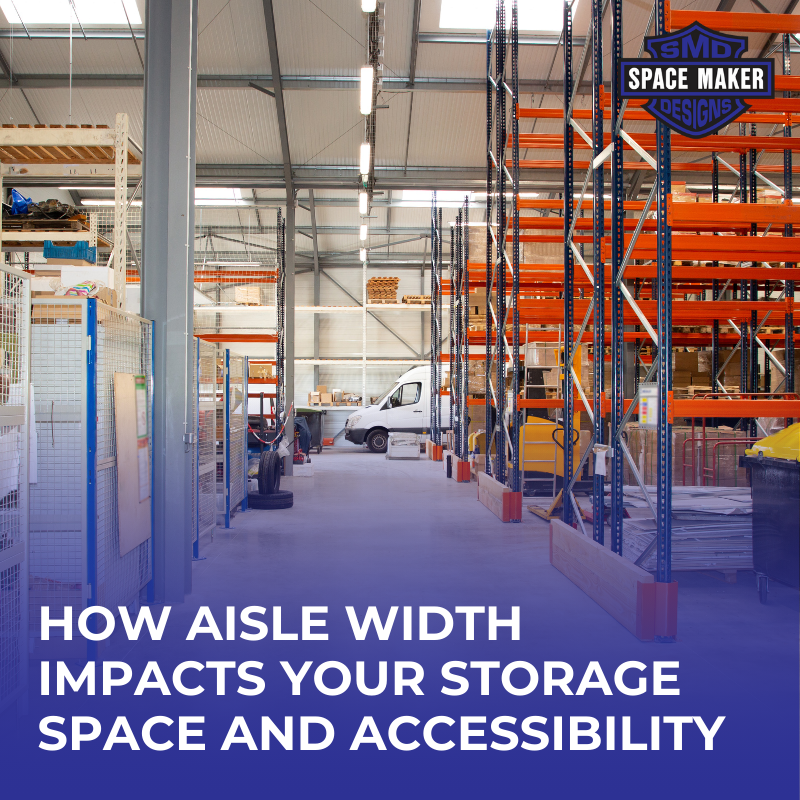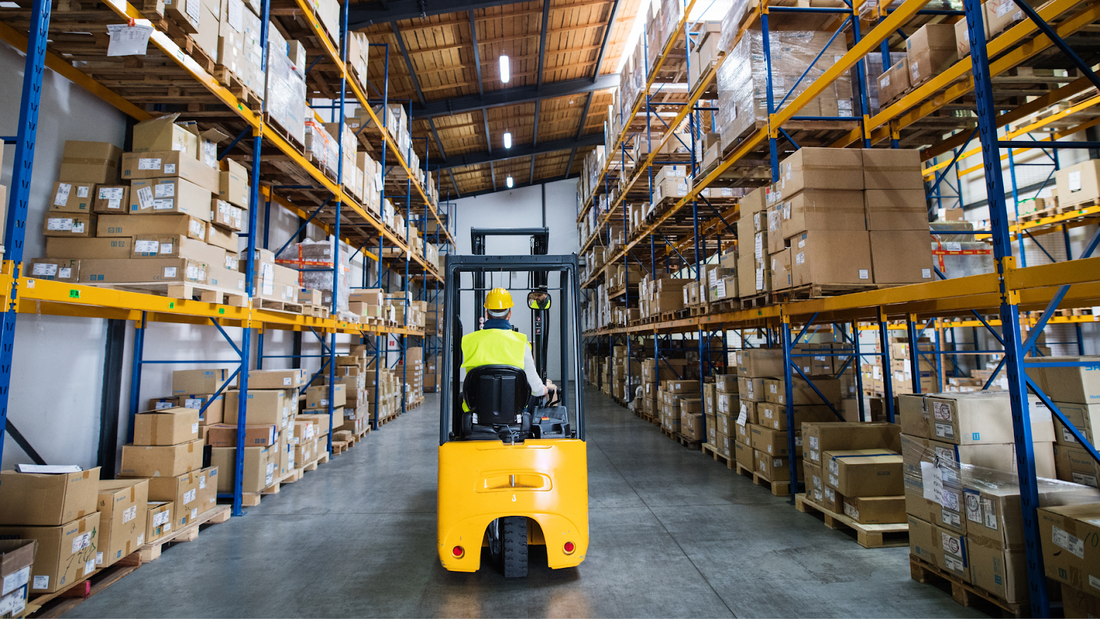Key Takeaways:
- Optimal Balance: Finding the right balance between maximizing storage space and ensuring accessibility and safety is crucial in determining aisle width.
- Regulatory Compliance: Adhering to regulations and best practices ensures safe and efficient warehouse operations.
- Strategic Planning: Careful consideration of operational needs, equipment, and future growth is essential for optimizing aisle width. Space Maker's warehouse design services ensure your facility is designed to meet these criteria efficiently, aligning with your business's specific needs for optimal performance and scalability.
When designing a warehouse, every detail matters, but one aspect that often gets overlooked is the aisle width. Yet, the space between your shelves and racks is not just a pathway; it's a crucial component of your storage solution that directly impacts your warehouse's overall efficiency, safety, and capacity. Aisle width determines how easily employees can access products, the type of equipment that can be maneuvered within the space, and how effectively inventory can be organized and stored. In essence, the decision on aisle width is not just about maximizing space; it's about optimizing your warehouse's functionality and operational flow. Integrating Space Maker's warehouse design services at this stage can significantly enhance this optimization process, ensuring a well-balanced and efficient warehouse layout.
Unlock The Power Of Smart Warehousing With Space Maker Designs!
- Largest Refurbisher in the South: With 56,000 sq. ft. of space on 5.6 acres, we're your trusted source for top-quality pallet racks, cantilever racks, drive-in racks, pallet-flow racks, push-back racks, and mezzanines in the South.
- Rack Repair Kits with 10-Year Warranty: Our Space Maker Rack Repair Kits are built to last and come with an unbeatable 10-year warranty against damage.
- Nationwide Installation Services: Our expert crews are ready to travel nationwide to install your rack repair kits, ensuring your warehouse stays efficient and safe.
- Immaculate Refurbished Products: Experience the difference with our "State of the Art" Powder-Coat Paint Line and 2 Baked-On Enamel Paint Lines. Our refurbished products look brand new, saving you money.
- Comprehensive Warehousing Solutions: From Systems Integration to Auto-CAD Layout and Design, Installation Services, Delivery, and Pallet Rack Repair, we've got your warehousing needs covered.
- Partner with the Experts: Trust our knowledge and experience to provide you with quality products tailored to your unique requirements. Let's build the perfect storage system together!
Understanding Aisle Width In Warehouse Design
Definition And Importance
Aisle width refers to the clear horizontal space between storage units or racks in a warehouse. This space is critical for the movement of goods and personnel. The right aisle width facilitates efficient operations, including picking, packing, and inventory management. It impacts everything from the type of material handling equipment used to the speed and safety of warehouse operations. Choosing the appropriate aisle width is a balancing act that involves considering the types of items stored, the equipment used for moving these items, and the warehouse's overall space utilization strategy.
Types Of Aisles And Their Uses
Warehouse aisles can be categorized based on their width: narrow, standard, and wide aisles. Each type serves different operational needs and equipment types.
- Narrow Aisles (NA) are typically between 8 to 10 feet wide and are suited for reach trucks and order pickers. They offer a higher storage density by reducing aisle space and increasing the shelving area.
- Standard Aisles (SA), about 10 to 12 feet wide, accommodate most counterbalanced forklifts, allowing for a balance between storage efficiency and accessibility.
- Wide Aisles (WA), exceeding 12 feet, are designed for larger equipment, including standard counterbalanced forklifts and specialized machinery. These aisles are common in warehouses prioritizing fast movement of goods and large equipment operation.
The Impact Of Aisle Width On Storage Space
Maximizing Storage Capacity
The width of aisles within a warehouse directly impacts the facility's total storage capacity. Narrower aisles mean more space can be allocated to storage units, racks, and shelves, thereby increasing the number of goods that can be stored. However, reducing aisle width to increase storage density must be carefully considered against the need for accessibility and the type of material handling equipment used. Optimal storage design seeks to find the right balance, ensuring that while storage capacity is maximized, operational efficiency and safety are not compromised. Strategic planning in aisle width can lead to significant improvements in storage capacity without sacrificing other critical operational aspects.
Aisle Width And Pallet Racking Systems
The relationship between aisle width and pallet racking systems is integral to maximizing storage space. Different racking configurations require different aisle widths to function effectively. For instance, selective racking systems, which offer high selectivity of stored goods, typically require standard to wide aisles for traditional forklift access. In contrast, high-density storage solutions like drive-in or push-back racking can operate with narrower aisles, as they are designed to maximize space utilization by reducing aisle space in favor of more pallet positions. Understanding the specific requirements of each pallet racking system and matching them with the appropriate aisle width is crucial for achieving an efficient storage layout.
Space Maker Designs' range of pallet racks and storage solutions can help optimize your warehouse layout to match these specific needs.
Space Maker Designs' range of pallet racks and storage solutions can help optimize your warehouse layout to match these specific needs.
Aisle Width And Operational Efficiency
Navigating Equipment and Personnel
The width of aisles in a warehouse has a profound impact on the efficiency of operations, particularly in terms of how equipment and personnel navigate the space. Narrow aisles can limit the types of equipment that can be used, potentially slowing down operations if not matched with the right machinery. On the other hand, too wide aisles might lead to underutilized space, reducing the overall efficiency of the warehouse. The key is to tailor aisle width to the specific needs of the handling equipment and the operational workflow. For instance, warehouses using high-reach forklifts or automated guided vehicles (AGVs) may benefit from narrower aisles, as these machines are designed to operate effectively in compact spaces. This careful matching of aisle width with equipment capabilities can significantly enhance operational speed and efficiency.
Safety Considerations In Aisle Design
Safety is a paramount concern in warehouse operations, and aisle width plays a critical role in ensuring a safe working environment. Adequate aisle space is essential for the safe maneuvering of equipment, reducing the risk of accidents and injuries. Narrow aisles might increase storage capacity but can also lead to congested working conditions, potentially increasing the likelihood of collisions or mishandling of materials. Additionally, wider aisles can facilitate better visibility and communication among workers, further enhancing safety. Compliance with local safety regulations and standards is also crucial in aisle design, as these guidelines are established to ensure the safety and well-being of personnel.
Optimizing Aisle Width For Accessibility
Balancing Space And Accessibility
Achieving the right balance between maximizing storage space and ensuring adequate accessibility is a critical challenge in warehouse design. Accessibility is not merely about being able to reach stored goods; it's about how quickly and safely items can be picked, stocked, and managed. Aisle width plays a fundamental role in this balance, influencing both the physical access to goods and the efficiency of storage and retrieval operations. Narrow aisles might increase storage density but can hinder accessibility if not aligned with the correct material handling equipment and operational practices. Conversely, wider aisles enhance accessibility and operational flexibility but at the cost of potential storage space. The optimal approach considers both the immediate and future needs of the warehouse, including growth projections and potential changes in inventory management practices.
Aisle Width Regulations And Best Practices
Compliance with regulations and adherence to best practices are essential when optimizing aisle width for accessibility. Regulatory requirements can vary by location but generally aim to ensure safe and efficient warehouse operations. These regulations often specify minimum aisle widths, clearances for fire safety, and other criteria essential for a safe working environment. Best practices go beyond mere compliance, focusing on optimizing operational flow, enhancing productivity, and ensuring the well-being of personnel. For example, adopting industry standards for material handling and storage can guide decisions on aisle width, ensuring that the warehouse operates efficiently and safely. Consulting with experts and leveraging industry resources can help in identifying and implementing the most effective aisle configurations for a given operation.
Final Thoughts
For businesses seeking to optimize their warehouse solutions, considering aisle width is not just an exercise in spatial planning but a strategic decision that can significantly enhance operational outcomes. Balancing the demands of storage capacity with the need for efficient and safe operations is key. By carefully evaluating their operational needs, regulatory requirements, and best practices, businesses can design warehouse spaces that not only meet their current needs but are adaptable to future growth and changes in the industry. Space Maker's warehouse design services can expertly guide this strategic planning, ensuring a future-ready solution.
Read also:
Read also:
- The Ultimate Guide to Choosing the Right Wire Shelving Unit for Your Space
- Top Industrial Shelving Solutions for Optimizing Your Warehouse Space
- 5 Key Benefits of Metal Shelving Systems for Organizing Your Space
Frequently Asked Questions
What is the minimum aisle width required by OSHA for pedestrian aisles?
OSHA does not specify a minimum width for pedestrian aisles unless it is part of an emergency egress route, which requires a minimum of 28 inches.
What is the impact of reducing warehouse aisle width?
Reducing warehouse aisle width from 12 feet to 8 feet can increase storage area by 15 to 20%.
How is aisle width calculated for pallet racking?
Calculate minimum aisle width by adding the head length of the forklift, load length, 12 inches for maneuverability, and 6 inches for pallet overhang.
How does aisle width affect forklift operation in warehouses?
Forklift aisle widths are based on technical specifications from manufacturers, affecting the design of storage installations.
How narrow can aisles be for certain types of forklifts?
For Swing-Reach trucks, aisles can be as narrow as 5.5 feet since no right angle stacking turns are required.
How does aisle width contribute to storage space efficiency?
Optimal aisle width allows for efficient use of space and equipment, impacting storage capacity and operational efficiency.
What factors should be considered when calculating warehouse aisle width?
Consider head length, load length, maneuvering space (add 12 inches for turning and stacking), and pallet overhang (add an additional 6 inches for safety).
What is the minimum aisle width for a sit-down counterbalanced forklift?
Approximately 13-feet wide for handling standard 48" long pallets.
What equipment is needed for narrow and very narrow aisles?
Narrow aisles require specialized equipment like turret trucks and order pickers, while very narrow aisles may need guided rail or wire systems and automated technology.
What are the pros and cons of narrow vs. wide aisles?
Narrow aisles maximize storage space but require specialized equipment and pose higher accident risks. Wide aisles offer easier maneuverability and lower accident risks but less storage space.



